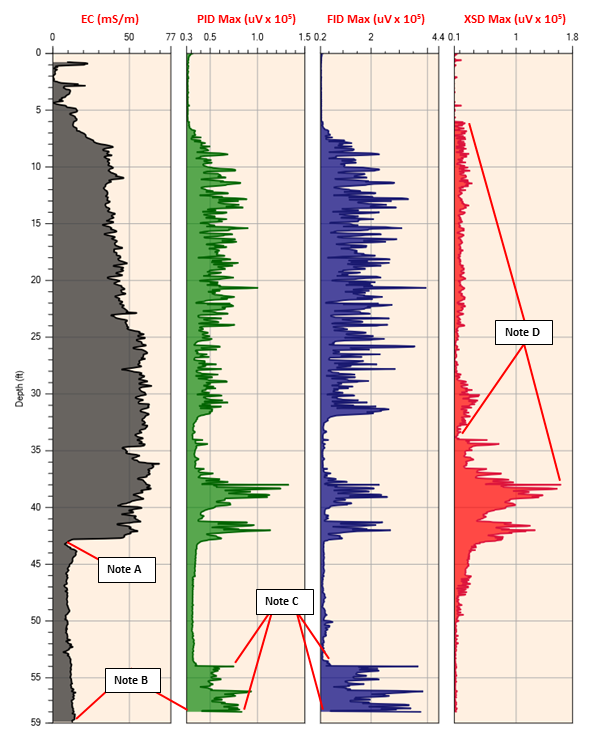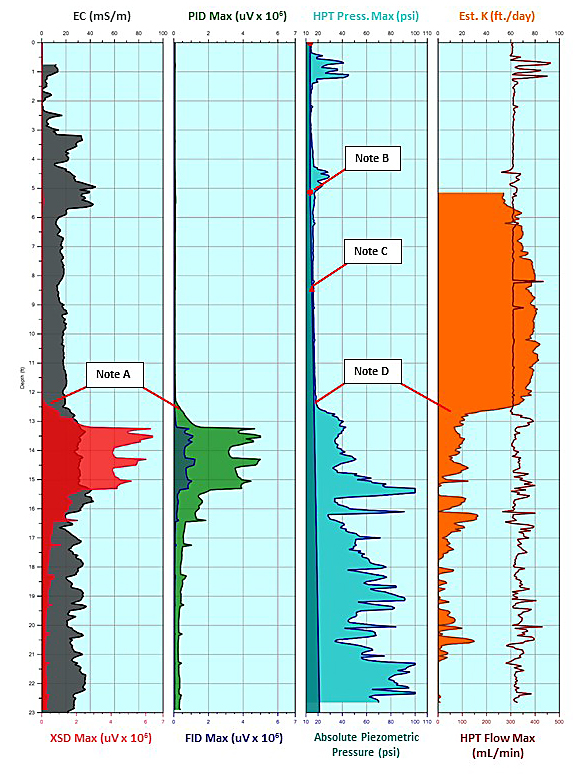MIP Log
Multiple MIP logs are produced to identify contaminant sources, to delineate the vertical and horizontal extent of a contaminant plume for remediation, or to investigate the efficacy of a remedial technology. Whatever the purpose of the MIP logging, there are always multiple logs used at any one site.
The MIP log shows the response of the MIP detectors with depth in the soil.
Log Components
 Electrical Conductivity
Electrical Conductivity
The Electrical Conductivity (EC) of the soil is logged simultaneously with the analytical detector data utilizing a dipole arrangement. The EC provides insight into stratigraphy and also contaminant pathways when viewed in relation to detector responses. Typically, an increase in EC is indicative of finer grained, tighter soil types.
PID Plot
Detects unsaturated, multi-bond compounds (olefins) and aromatic (BTEX) hydrocarbons to approximately 0.5 to 1 ppm detection limit in all types of soil. Responses are recorded in microvolts.
FID Plot
Detects all types of hydrocarbons (including methane and butane) to approximately 10 ppm detection limit. Generally, the FID response is an indication of total hydrocarbons present.
XSD Plot
Detects halogenated compounds (i.e. TCE, PCE) to approximately 250 ppb detection limit.
Note A:
Decreasing EC readings starting at 43 feet are indicative of a transition from a finer soil type (glacial till containing clay) to coarser (sandy) soil type.
Note B:
The MIP probe was pushed until refusal (push rate of less than 1 ft. /min.) was achieved at 58 feet. Note that the EC readings are recorded to 59 feet. This is because the EC dipole is located approximately 1 foot lower on the probe relative to the membrane.
Note C:
PID and FID responses (in the absence of an XSD response) at 54 to 58 feet are indicative of aromatics or other unsaturated hydrocarbon contamination (50 to 100 ppm gas in this example).
Note D:
XSD responses at 6 to 34 feet indicate halogenated compounds (TCE and daughter products at 1 to 5 ppm in this example) at corresponding depths. The maximum peak at 38 feet indicates a relatively higher concentration (50 to 100 ppm in this example) of contaminant.
MiHpt Log
Multiple MiHpt logs are produced to identify contaminant sources, delineate the vertical and horizontal extent of a contaminant plume and measure large and small scale changes in formation permeability. Together, these data contribute to the development of a robust conceptual site model, enabling the practitioner to efficiently investigate the efficacy of remedial technologies. Whatever the purpose of the MiHpt logging, there are always multiple logs used at any one site.
The MiHpt log shows the response of the MIP detectors and HPT injection pressure with depth in the soil.
Log Components
 Electrical Conductivity
Electrical Conductivity
The Electrical Conductivity (EC) of the soil is logged simultaneously with the HPT pressure and analytical detector data utilizing a dipole arrangement. The EC provides insight into stratigraphy and contaminant pathways when viewed in relation to detector responses. Typically, an increase in EC is indicative of finer grained, tighter soil types.
HPT Pressure Plot
The HPT pressure gives insight into hydraulic properties of the soil as water is pumped into the formation at a constant rate. The pressure (unlike EC) is independent of certain factors such as pore water chemistry or mineralogy (contaminants, brines), and so further aids in defining soil/hydraulic properties. Potential contaminant migration pathways can be better understood when pressure data are viewed in relation to detector responses.
Estimated K Plot
Estimated K is internally calculated with pressure and flow data in conjunction with dissipation tests performed at each location. Hydraulic conductivity data is useful for directing sampling, remediation and slug testing protocols.
PID Plot
Detects unsaturated, multi-bond compounds (olefins) and aromatic (BTEX) hydrocarbons, as well as GRO to approx. 0.5-1 ppm detection limit in all types of soil.
FID Plot
Detects all types of hydrocarbons (including methane and butane) to approximately 10 ppm detection limit. Generally, the FID response is an indication of total VOCs/CVOCs present.
XSD Plot
Detects halogenated compounds (i.e. CVOCs such as TCE and PCE) to approximately 250 ppb detection limit.
Note A:
XSD (and PID/FID) responses starting at 12.5 feet are indicative of moderate level CVOCs.
Note B:
The hydrostatic water level is indicated with a round marker at 5.2 feet.
Note C:
The Absolute Piezometric pressure has been calculated and graphed with the dissipation test point indicated by a triangular marker at 8.4 feet. The pressure begins to increase relative to the head pressure as soon as the water table is encountered, producing the rising piezometric pressure baseline after 5.5 feet.
Note D:
Increasing pressure readings starting at 12.5 feet are indicative of a less permeable soil type (clay). Note that this pertinent data (related to contaminant flow pathway) is not dramatically discerned by the EC plot. Sinking, dense CVOCs are “trapped” in this less transmissive zone (see Est. K plot).